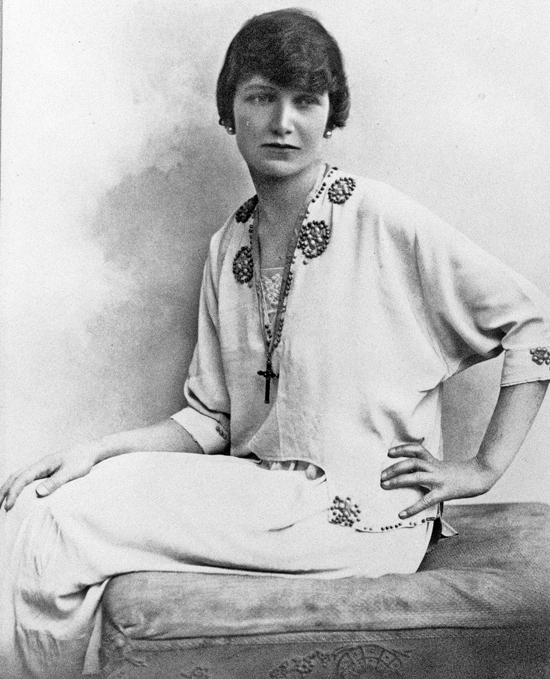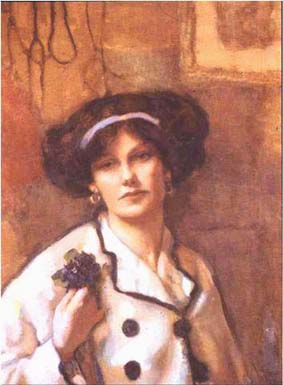AN IMPORTANT work by a leading Helensburgh artist of the past, Norah Neilson Gray, is on display in Helensburgh Library.
The painting, “Hôpital Auxilaire D’Armée 30, Abbaye de Royaumont” by Norah Neilson Gray, was gifted to the people of Helensburgh by the artist’s sister, Dr Tina Gray, on her death in 1984.
For four years it awaited a suitable location where, in accordance with the donor’s wishes, it could be permanently on display in the burgh.
Now, thanks to the efforts of Argyll and Bute Area Librarian Pat McCann, it hangs in the Gallery of the West King Street library.
At first glance, the setting of this painting is hardly local or even Scottish. It is the vaulted reception area of the Royaumont Abbaye, near Paris, as it was in 1918 when it served as a Red Cross hospital.
It was staffed entirely by women of the Scottish Women’s Hospitals, one of whom was the artist of this painting, Norah Neilson Gray, who served as a Voluntary Aid Detachment nurse.
 Norah Neilson Gray (left) was born in 1882 at Carisbrook in West King Street and began her artistic career at “The Studio”, a private drawing establishment at Craigendoran where she was taught by Miss Park and Miss Ross.
Norah Neilson Gray (left) was born in 1882 at Carisbrook in West King Street and began her artistic career at “The Studio”, a private drawing establishment at Craigendoran where she was taught by Miss Park and Miss Ross.
She moved to Glasgow about 1901 with her family and that year began give years of study at Glasgow School of Art under Fra Newberry and the Belgian Symbolist painter Jean Delville.
She is now regarded as part of the group known as the “Glasgow Girls”, which included Evelyn Carslaw, Eleanor Moore and Margaret Macdonald.
While still a student, she had a picture accepted by the Royal Academy and was becoming recognised for her distinctive use of colour and composition and, above all, for her talent as a portrait painter.
In 1909, Norah joined the Art School staff herself after completing training, and taught fashion-plate drawing. She also taught at St Columba’s School for Girls in Kilmacolm, where she was known as ‘Purple Patch’ because she was always asking her pupils to look for colour in the shadows.
By 1910 she had a studio in Bath Street and had held her first one-woman show in Glasgow, at Warneuke’s Gallery, having previously submitted works to exhibitions at the Royal Academy, the Glasgow Institute and in Paris. In 1914 Norah became a member of the Royal Scottish Society of Painters in Watercolour.
 The First World War years, 1914-18 inspired some of her most powerful paintings, many of which were acquired by public collections.
The First World War years, 1914-18 inspired some of her most powerful paintings, many of which were acquired by public collections.
While working as a Voluntary Aid Detachment nurse at the Royaumont hospital she used her limited spare time to draw soldiers and staff and the lofty vaulted cloisters of the Abbaye. These later resulted in the masterful group portrait now on show.
After the war, Norah offered this painting to the Imperial War Museum because she felt “it was painted from within, at the time and absolutely true to fact”.
She believed that the War Museum should have a record of what was done “by the British for the French Army in the way of Hospitals”. She was adamant that the painting should be acquired for the General Section and not be consigned to the Women’s Work Section, as the museum proposed.
Unfortunately for the museum, but not for Helensburgh, her offer was refused because the purchasing budget for the General Section had been exhausted.
A year later, however, the Imperial War Museum commissioned her to paint a record of the staff at the hospital and this rather more formal painting now forms part of the Museum’s collection.
 Both these Royaumont paintings were on display at the Royal College of Surgeons’ quincentenary exhibition in Edinburgh in 2008.
Both these Royaumont paintings were on display at the Royal College of Surgeons’ quincentenary exhibition in Edinburgh in 2008.
Back in Glasgow after the war, Norah resumed her career as a portrait painter and also began painting from the family’s home on Loch Long, an area which inspired many of her most lyrical watercolours.
1921 was to prove a very successful year for Norah. One of her paintings from the war period, The Belgian Refugee, won her a bronze medal in Paris, and she became the first woman to be appointed to the Hanging Committee of the Royal Glasgow Institute of the Fine Arts, alongside Helensburgh artist James Whitelaw Hamilton and silversmith Bailie Robert Laing.
The Committee’s responsibility as “hangers” was to group the pictures exhibited in as effective a manner as possible, to enhance the overall effect.
Despite suffering from cancer, she continued painting and exhibiting in Scotland, London and Paris — winning further medals at the 1923 Paris Saloon — until her early death on May 27 1931 in Glasgow.
- The self portrait of Norah Neilson Gray belongs to her descendant, Professor Edward Armour.




